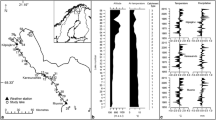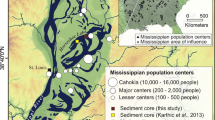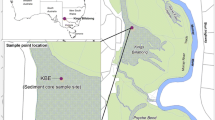Abstract
Coastal wetlands are essential to the ecosystem health of the Laurentian Great Lakes (North America) watershed. Multiple anthropogenic stressors have been impacting coastal wetlands since European settlement ca. 1850, and remain a concern for wetland health as watershed development intensifies. We used paleolimnological techniques to explore temporal ecosystem dynamics over the last ~ 100 years in two highly degraded Lake Ontario coastal wetlands located in southern Ontario, Canada, using Cladocera (Branchiopoda, Crustacea) subfossil remains as paleoecological indicators. In Cootes Paradise Marsh (Hamilton, Ontario), cladoceran assemblage changes exhibited a shift in dominance from Chydorus to Bosmina, at the turn of the twentieth century. That shift likely reflected the loss of aquatic macrophytes, and corresponds to the postulated timing of the arrival of invasive carp. Despite recent remediation efforts, including attempts to exclude carp from the wetland, little ecological recovery is evident from the subfossil Cladocera assemblage. No Daphnia remains were observed in our sediment core from Cootes Paradise, in contrast to previous studies on extant zooplankton communities, which reported a large Daphnia population in the west end of the marsh in the 1940s. This could indicate that our sediment core recorded ecological changes solely in the east end of Cootes Paradise Marsh. In Jordan Harbour (Lincoln, Ontario), Bosmina were dominant throughout the sediment record, and increases in littoral cladocerans were observed in the most recent sediments, in particular the appearance of periphytic Pleuroxus taxa after ~ 2008. This suggests that some recovery of aquatic macrophyte communities occurred in response to shoreline remediation efforts. Bosmina size structure exhibited only minimal changes in both wetlands, despite known large changes in historic fish community structure. Overall, our study provides perspectives on the benefits and limitations of paleolimnology for documenting ecological change in the Laurentian Great Lakes coastal wetlands.






Similar content being viewed by others
References
Ahn YS (2018) Recent changes in sedimentation rate in three lakes of Ishikari Wetland, Northern Japan determined by 210Pb dating. Water Resour 45:795–802
Albert AD, Wilcox DA, Ingram JW, Thompson TA (2005) Hydrogeomorphic classification of great lakes coastal wetlands. J Gt Lakes Res 31:129–146
Appleby PG (2001) Chronostratigraphic techniques in recent sediments. In: Last WM, Smol JP (eds) Tracking environmental change using lake sediments. Vol. 1: basin analysis coring and chronological techniques. Kluwer Academic Publishers, Dordrecht, pp 172–203
Bennett KD (1996) Determination of the number of zones in a biostratigraphical sequence. New Phytol 132:155–170
Chow-Fraser P (1998) A conceptual ecological model to aid restoration of Cootes Paradise Marsh, a degraded coastal wetland of Lake Ontario, Canada. Wetl Ecol Manag 6:43–57
Chow-Fraser P, Lougheed V, Le Thiec V, Crosbie B, Simser L, Lord J (1998) Long-term response of the biotic community to fluctuating water levels and changes in water quality in Cootes Paradise Marsh, a degraded coastal wetland of Lake Ontario. Wetl Ecol Manag 6:19–42
Chow-Fraser P (2005) Ecosystem response to changes in water level of Lake Ontario marshes: lessons from the restoration of Cootes Paradise marsh. Hydrobiologia 539:189–204
Chow-Fraser P (2006) Development of the water quality index (WQI) to assess effects of basin wide land use alteration on coastal marshes of the Laurentian Great Lakes. In: Simon TP, Stewart PM (eds) Coastal wetlands of the Laurentian Great Lakes: health, habitat and indicators. Author House, Bloomington, pp 137–166
City of Hamilton (2017) Cootes Paradise Marsh. https://www.hamilton.ca/city-initiatives/our-harbour/cootes-paradise-marsh
Croft MV, Chow-Fraser P (2009) Non-random sampling and its role in habitat conservation: a comparison of three wetland macrophyte sampling protocols. Biodivers Conserv 18:2283–2306
Finkelstein SA, Peros MC, Davis AM (2005) Late Holocene paleoenvironmental change in a Great Lakes coastal wetland: integrating pollen and diatom datasets. J Paleolimnol 33:1–12
Florian N, Lopez-Luque R, Ospina-Alvarez N, Hufnael L, Green AJ (2016) Influence of a carp invasion on the zooplankton community in Laguna Medina, a Mediterranean shallow lake. Limnetica 35:397–412
Gell P, Mills K, Grundell R (2013) A legacy of climate and catchment change: the real challenge for wetland management. Hydrobiologia 708:133–144
Grimm EC (1987) CONISS: a FORTRAN 77 program for stratigraphically constrained cluster analysis by the method of incremental sum of squares. Comput Geosci 13:13–35
Host GE, Kovalenko KE, Brown TN, Ciborowski JJ, Johnson LB (2019) Risk-based classification and interactive map of watersheds contributing anthropogenic stress to Laurentian Great Lakes coastal ecosystems. J Gt Lakes Res 45:609–618
Juggins S (2020) rioja: analysis of quaternary science data. R package version 0.9-26. https://cran.r-project.org/package=rioja
Kerfoot WC (1975) The divergence of adjacent populations. Ecology 56:1298–1313
Kim DK, Peller T, Gozum Z, Theysmeyer T, Long T, Boyd D, Watson S, Rao YR, Arhonditsis GB (2016) Modelling phosphorus dynamics in Cootes Paradise Marsh: uncertainty assessment and implications for eutrophication management. Aquat Ecosyst Health Manag 19:368–381
King DR, Hunt GS (1967) Effect of carp on vegetation in a Lake Erie marsh. J Wildl Manag 31:181–188
Korhola A, Rautio M (2001) Cladocera and other branchiopod crustaceans. In: Smol JP, Birks HJB, Last WM (eds) Tracking environmental change using lake sediments. Developments in paleoenvironmental research, vol 4. Springer, Dordrecht, pp 5–41
Korosi JB, Paterson AM, DeSellas AM, Smol JP (2010) A comparison of pre-industrial and present-day changes in Bosmina and Daphnia size structure from soft-water Ontario lakes. Can J Fish Aquat Sci 67:754–762
Korosi JB, Smol JP (2012a) An illustrated guide to the identification of cladoceran subfossils from lake sediments in northeastern North America: part 1—the Daphniidae, Leptodoridae, Bosminidae, Polyphemidae, Holopedidae, Sididae, and Macrothricidae. J Paleolimnol 48:571–586
Korosi JB, Smol JP (2012b) An illustrated guide to the identification of cladoceran subfossils from lake sediments in northeastern North America: part 2—the Chydoridae. J Paleolimnol 48:587–622
Korosi JB, Kurek J, Smol JP (2013) A review on utilizing Bosmina size structure archived in lake sediments to infer historic shifts in predation regimes. J Plankton Res 35:444–460
Kurek J, Korosi JB, Jeziorski A, Smol JP (2010) Establishing reliable minimum count sizes for cladoceran subfossils sampled from lake sediments. J Paleolimnol 44:603–612
Lee SY, Dunn RJK, Young RA, Connolly RM, Dale PER, Dehayr R, Lemckert CJ, Mckinnon S, Powell B, Teasdale PR, Welsh DT (2006) Impact of urbanization on coastal wetland structure and function. Austral Ecol 31:149–163
Lintern A, Leahy PJ, Zawadzki A, Gadd P, Heijnis H, Jacobsen G, Connor S, Deletic A, McCarthy DT (2016a) Sediment cores as archives of historical changes in floodplain lake hydrology. Sci Total Environ 544:1008–1019
Lintern A, Leahy PJ, Heijnis H, Zawadzki A, Gadd P, Jacobsen G, Deletic A, Mccarthy DT (2016b) Identifying heavy metal levels in historical flood water deposits using sediment cores. Water Resour 105:34–46
Lord J (1993) Cootes Paradise as it was. Pappus 12:29–33
Lougheed VL, Theÿsmeÿer T, Smith T, Chow-Fraser P (2004) Carp exclusion, food-web interactions, and the restoration of Cootes Paradise Marsh. J Gt Lakes Res 30:44–57
Mayer T, Rosa F, Charlton M (2005) Effect of sediment geochemistry on the nutrient release rates in Cootes Paradise Marsh, Ontario, Canada. Aquat Ecosyst Health Manag 8:133–145
Maynard L, Wilcox D (1997) Coastal wetlands. State of the lakes ecosystem conference 1996 background paper
Matveev VF (1991) Self-maintaining plankton: pelagic Cladocera in small microcosms with lake water. Hydrobiologia 225:301–307
Meriano M, Eyles N, Howard KW (2009) Hydrogeological impacts of road salt from Canada’s busiest highway on a Lake Ontario watershed (Frenchman’s Bay) and lagoon, City of Pickering. J Contam Hydrol 107:66–81
Morrice JA, Danz NP, Regal RR, Kelly JR, Niemi GJ, Reavie ED, Hollenhorst T, Axler RP, Trebitz AS, Cotter AM, Peterson GS (2008) Human influences on water quality in Great Lakes coastal wetlands. J Environ Manag 41:347–357
Niagara Peninsula Conservation Authority (2015) Jordan Harbour. https://npca.ca/parks/jordan-harbour
Oksanen J, Blanchet FG, Kindt R, Legendre P, Simpson G, Solymos P, Stevens MHH, Wagner H (2012) vegan: Community ecology package. R package version 2.0-7. https://cran.r-project.org/web/packages/vegan/vegan.pdf
Ontario’s Invading Species Awareness Program (2019) Asian Carps. http://www.invadingspecies.com/asian-carps/
Painter DS, Hampson L, Simer WL (1989) Cootes Paradise water turbidity: sources and recommendations. National Water Research Institute
Post DM, Frost TM, Kitchell JF (1995) Morphological responses by Bosmina longirostris and Eubosmina tubicen to changes in copepod predator populations during a whole-lake acidification experiment. J Plankton Res 17:1621–1632
Rosts S (2010) NPCA opening conservation area in Jordan Harbour. Niagara This Week. https://www.niagarathisweek.com/community-story/3308446-npca-opening-conservation-area-in-jordan-harbour/
Royal Botanical Gardens (1998) The Cootes Paradise Fishway Carp control techniques. Royal Botanical Gardens, Hamilton
RStudio Team (2020) RStudio: Integrated Development for R. RStudio, PBC, Boston, MA. http://www.rstudio.com/
Sakamoto M, Hanazato T (2008) Antennule shape and body size of Bosmina: key factors determining its vulnerability to predacious Copepoda. Limnology 9:27–34
Sierszen ME, Morrice JA, Trebitz AS, Hoffman JC (2012) A review of selected ecosystem services provided by coastal wetlands of the Laurentian Great Lakes. Aquat Ecosyst Health Manag 15:92–106
Sprules WG, Carter JCH, Ramcharan CW (1984) Phenotypic associations in the Bosminidae (Cladocera): zoogeographic patterns. Limnol Oceanogr 29:161–169
Thomasen S, Chow-Fraser P (2012) Detecting changes in ecosystem quality following long-term restoration efforts in Cootes Paradise Marsh. Ecol Indic 13:82–92
Tremel B, Frey S, Yan ND, Somers KM, Pawson TW (2000) Habitat specificity of littoral Chydoridae (Crustacea, Branchiopoda, Anomopoda) in Plastic Lake, Ontario, Canada. Hydrobiologia 432:195–205
United States Environmental Protection Agency (2019a) Summary of the Great Lakes Coastal Wetland Monitoring Program (CWMP). https://www.epa.gov/great-lakes-monitoring/summary-great-lakes-coastal-wetland-monitoring-program-cwmp
United States Environmental Protection Agency (2019b) Importance of Great Lakes Coastal Wetlands. https://www.epa.gov/great-lakes-monitoring/importance-great-lakes-coastal-wetlands
Uzarski DG, Brady VJ, Cooper MJ, Wilcox DA, Albert DA, Axler RP, Bostwick P, Brown TN, Ciborowski JJ, Danz NP, Gathman JP (2017) Standardized measures of coastal wetland condition: implementation at a Laurentian Great Lakes basin-wide scale. Wetlands 37:15–32
Van Dongen M (2019) Hamilton kept sewage spill details secret from the agency responsible for Cootes Paradise. Hamilton Spectator, Hamilton, ON. https://www.mississauga.com/news-story/9733251-hamilton-kept-sewage-spill-details-secret-from-the-agency-responsible-for-cootes-paradise/
Vincent K (2017) 2017 Environmental Condition of Cootes Paradise South Shore. RBG Report No. 2018-12. Royal Botanical Gardens. Burlington, ON
Wei A, Chow-Fraser P (2005) Untangling the confounding effects of urbanization and high water level on the cover of emergent vegetation in Cootes Paradise Marsh, a degraded coastal wetland of Lake Ontario. Hydrobiologia 544:1–9
Acknowledgements
We thank Dr. David Galbraith and Tys Theysmeyer of the Royal Botanical Gardens for providing feedback on the study design for Cootes Paradise marsh, as well as Joshua Thienpont and Kristen Coleman for fieldwork assistance. This study was funded by a York University minor research grant to JBK.
Author information
Authors and Affiliations
Corresponding author
Additional information
Publisher's Note
Springer Nature remains neutral with regard to jurisdictional claims in published maps and institutional affiliations.
Rights and permissions
About this article
Cite this article
Hoskin, G.N., Korosi, J.B. Long-term ecosystem change in two highly degraded Lake Ontario (Canada) coastal wetlands. J Paleolimnol 65, 393–405 (2021). https://doi.org/10.1007/s10933-021-00177-x
Received:
Accepted:
Published:
Issue Date:
DOI: https://doi.org/10.1007/s10933-021-00177-x




